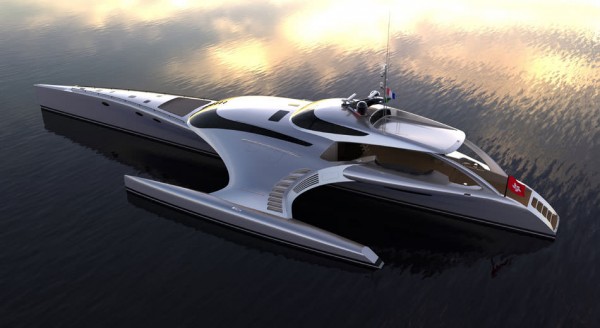Described by Boat International as “one of the world’s most amazing super-yachts, that could spell the future for efficient long range cruising”, the striking 42.5m Trimaran Adastra was designed by John Shuttleworth and launched in China for Hong Kong clients Anto and Elaine Marden.
Adastra is the result of meticulous attention to detail and innovative design to create a yacht that meets the needs of a very experienced ocean voyaging couple and their family, and to provide the level of comfort and style expected in a yacht of this class and size, with exceptionally low fuel consumption, offering luxurious accommodation. Measurements taken during the sea trials show that her fuel consumption at 10.5 knots is as low as 17 litres per hour when carrying 10% fuel and water. At cruising load (20 tonnes fuel and water) she uses just 25 litres per hour therefore on delivery trips her range is 10,000 miles starting with 30,000 litres of fuel. Her slender hulls and streamlined exterior allow her to travel faster in the open ocean and at 17 knots she has a 4,000 mile range so can comfortably cross both the Atlantic and Pacific oceans at hi-speed.
Adastra takes the power trimaran concept further than has ever been attempted before, previous vessels like Earthrace and Cable and Wireless were stripped out record breaking machines. The challenge of turning this concept into a viable luxury yacht has led to further research and develop new thinking on stability and comfort at sea for this type of craft. Extensive tank testing and radio controlled model tests in waves have been carried out to analyse stability and performance. Outrigger height has been optimised for ease of motion at sea, and a new outrigger shape has been developed to increase stability in waves. The designers have undertaken state of the art structural analysis of all the major components in the yacht in order to achieve the light weight required for very low fuel consumption. The deck and superstructure is therefore constructed from carbon fibre with Nomex honeycomb core, the hull is glass/kevlar foam sandwich and the interior is light weight oak cabinetry using honeycomb panels. To help reduce weight further, virtually every aspect of the boat was custom built. This includes carbon fibre hatches, toilets, portlights and ladders, which are all built specifically for the vessel.
Aerodynamics and hydrodynamics above the water line were also carefully considered as they developed the overall exterior shape and kept the boat streamlined both for air and water passing over the structure. The smooth seamless, unbroken surfaces also help to reduce weight as the outer-skin forms part of the structure to absorb torsional loads.
Do note, that Adastra’s 16 metre beam creates a spacious saloon area on the main deck which offers superb views through a panoramic window and accommodates a lounge area, dining table and navigation station. A forward facing door through the saloon window gives easy access to a large sunbed on the foredeck. The aft deck has a sofa and bar area to port and a dining area to starboard, further aft there is space for a 4.9 metre tender and directly below is a garage which can store a 3.1 metre tender. The garage door has been designed to fold out and create a large dive platform. The main helm station, which has seating for two, is positioned in a raised pilot house situated between the aft deck and the saloon area and forms part of the cross beam structure. Extra space has been created below deck by slightly flaring the central hull just above the waterline. This area has been split into two sections with a full-width master cabin located aft with access from the deck saloon, and two further guest cabins, accommodation for the crew, and the galley located forward of the engine compartment. Adastra offers comfortable accommodation for nine guests and up to six crew members.
